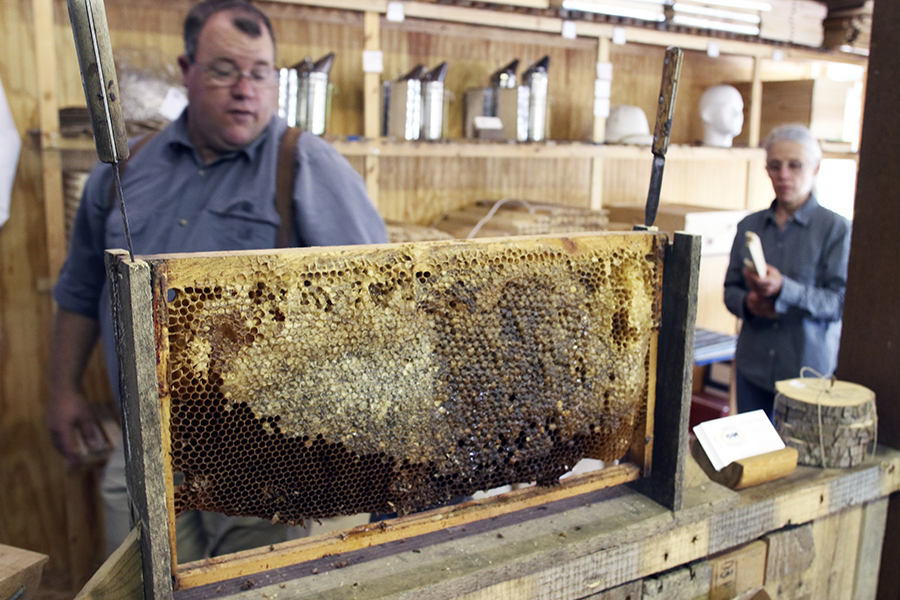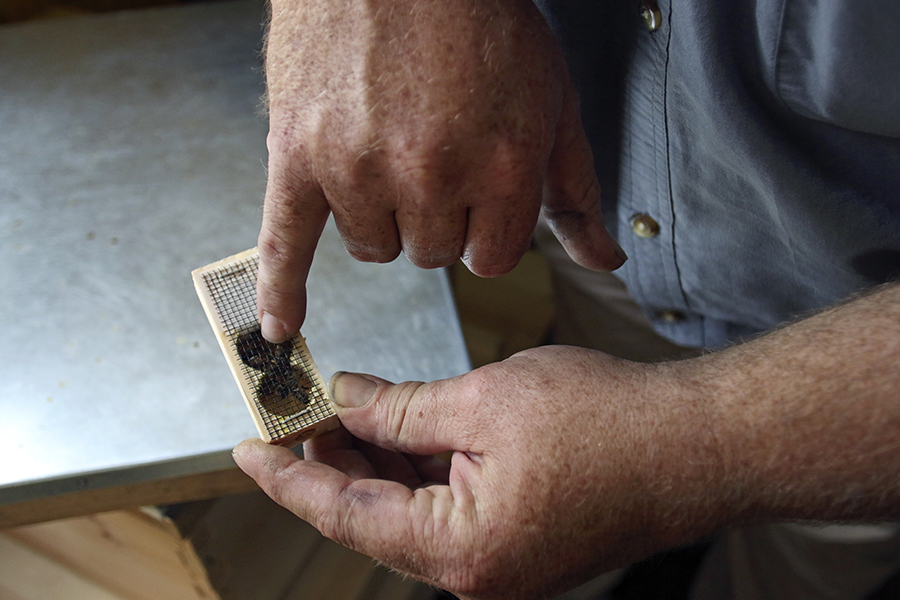It’s 49 degrees on a late-spring day, and that’s good news for the five people hanging out with millions of honeybees in this bear-fenced yard west of Whitefish.
Colder weather makes the bees slower, keeping them from forming in clouds of thousands that sound like an angry buzz saw. Instead, the bees cuddle together on the suits protecting the folks from Great Northern Honey Company, soaking up the warmth from the humans.
Once a year, Amy and David Hooks, along with David’s parents from southwest Montana, funnel their bees into 60 three-pound boxes to sell to hobbyists. This bee yard is one of many the company runs, with half of their bees living east of the Continental Divide. With thousands of hives to run, culling some of the bees helps keep the rest of the population healthier, David said as he took a hive frame and hit it against a wooden funnel, shaking the bees free into a box below.
“We’ve never had weather like this when we do this,” he said. “This is the best weather you could hope for.”
The bees in this yard will float from bloom to bloom — dandelions, roses, willows, alfalfa, various river weeds — giving their honey a local taste, unique to the area.
Honeybee wranglers — called beekeepers and apiarists — face all sorts of challenges raising their insects in Northwest Montana, weather being a big one. Winters are hard on the bees; the Hookses, like many professional beekeepers, send most of their bees to Southern California almond orchards during the cold season.
Western beekeepers also have to contend with increasingly intense wildfire seasons, the smoke from which shuts down the bees’ ability to communicate with each other via pheromones and makes their work even harder.
But the potential difficulties haven’t deterred many professional and hobbyists from pursuing their passion for the tiny creatures, who, along with their millions of cohorts around the state, are responsible for keeping Montana in the top five honey-producing states in the country.

According to the U.S. Department of Agriculture, Montana ranked second in 2016 for honey production, with its bees making 12,243,000 pounds of honey worth more than $21 million. North Dakota produced roughly triple that amount.
Though honeybee colony losses across the country have persisted for years, last year was particularly hard on them. The Honey Bee Health Coalition — a group of 50 organizations supporting bee and pollinator health — released a national survey showing that 40 percent of managed honeybee colonies in the U.S. were lost between April 1, 2017 and March 31, 2018. Beekeepers reported 30.7 percent colony loss over the winter.
The Hookses keep close eyes on their colonies to ensure they are healthy and happy, knowing full well that commercial beekeepers in the state and across the country have been put out of business by such mortality rates.
“We didn’t ever have any huge losses,” Amy Hooks said. “Dave diligently goes through hives to build them up and keep them strong.”

Lisa Foley, owner and operator of Tamarack Apiaries in Kalispell and other bee-related businesses throughout the valley, said ongoing research into colony losses makes the challenge of keeping bees more manageable.
“I think overall, what everybody is feeling, because we’ve identified some of the problems, we know what we’re dealing with and it feels less scary,” Foley said.
Northwest Montana has its losses, she said, but those are largely due to winter. A hive can survive the cold just fine, but the way it’s ventilated could kill the bees: if there is too much moisture, it freezes the insects.
“How to ventilate the hives properly so you’re not chilling them, and how to get the right amount of fresh air in the hives, in the northern area, this is the number one problem,” she said.
It’s this kind of information that has Foley and her husband, Wade Foley, in high demand around the Flathead Valley. They opened up the apiary shop in Kalispell a few years ago not realizing how popular their knowledge and wares would be.
“Everybody is into bees,” Wade Foley said during a break between helping customers.

The shop is only open Thursday and Friday to allow the Foleys time to attend to their other jobs, which include running their own bee yards to raise northern hardy queen bees, selling bees, and servicing hives around the valley. The Foleys are also in financing discussions to buy a commercial bee operation out of Colorado, with the intention of moving it to the Flathead and providing a commercial kitchen and honey-extraction equipment for hobbyists to lease.
The Foleys are also the leaders of the Flathead Valley Beekeepers Association, and Wade teaches classes at Flathead Valley Community College, though this year has proven too busy to teach as much as he’d like. There’s a major interest in bees and their products, he said.
“I’m just filling a niche,” he said. “It was just going to be a two-days-a-week thing; I didn’t even know we could make a living with bees.”
Amy and David Hooks stumbled on this secret a dozen years ago when they started their business. In the bear-fence-secured bee yard west of Whitefish, the Hooks family has a friendly relationship with its buzzing business partners.
Honeybees are typically docile, only stinging when threatened, and Amy Hooks likes to think of them as industrious coworkers as much as her livelihood. There’s affection and a respect for the creatures, a drive that keeps apiarists looking for better ways to keep them alive and pollinating.
“When you start opening hives and looking in, you stare at them and watch their actions,” she said. “You just do your thing and they do theirs.”
For more information on Great Northern Honey Company, visit www.greatnorthernhoneyco.com. For more information on Tamarack Apiaries, visit www.bees4u.net or call (406) 890-2337.
Read more of our best long-form journalism in Flathead Living. Pick up the summer edition for free on newsstands across the valley.
